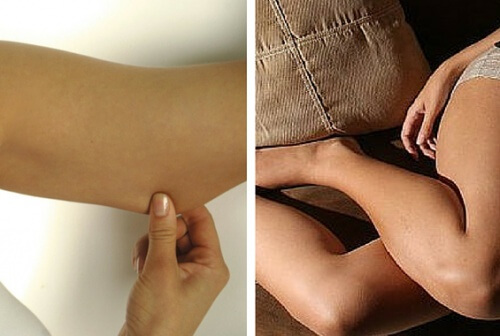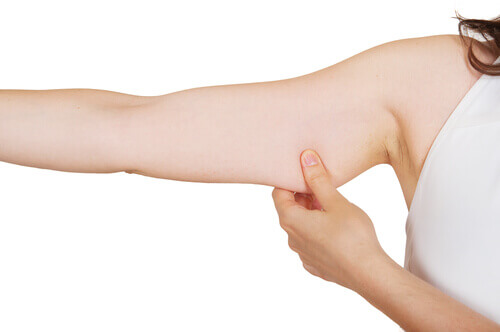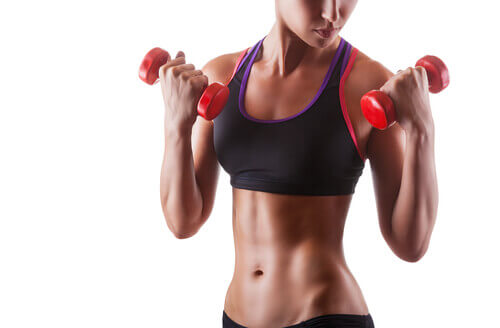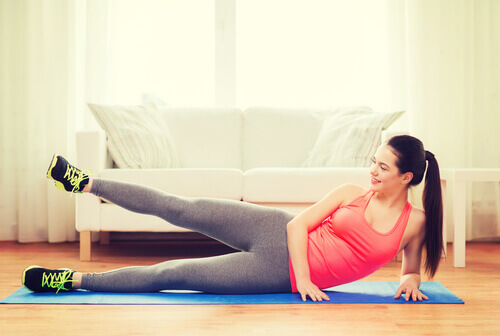Firm and Tone Your Arms and Legs


Reviewed and approved by Doctor Carlos Fabián Avila
Your arms and legs are more susceptible to sagging than other parts of the body and as a consequence of constant weight gain and loss. Because of this, in today’s article we’ll be showing you how to firm and tone your arms and legs.
Sagging is the result of sudden weight changes which causes the skin to stretch to accommodate fat stores. By losing excess weight in an unhealthy way, the skin loses its firmness and requires a lot of work to restore it.
This problem is unsightly due to the changes it causes in these parts of the body. Luckily, there’s a lot you can do to combat it and restore the firmness you’re longing for.
Why is it so difficult to fight sagging?
Restoring firmness to any area of the body is no easy task. Once the skin is stretched, it then requires constant effort to restore it to its natural state.
Collagen and elastin are responsible for giving the skin its elasticity and firmness, both of which play an important role in the health of your skin. When your body stops producing both of these substances in sufficient quantities, then premature wrinkling and sagging begin to occur.

These substances are normally depleted as a part of the normal aging process that affects everyone.
However, by rapidly losing weight without the help of exercise, the skin doesn’t have enough time to restore its lost firmness. As a result, it’s more difficult to return it to its normal state.
Visit this article: Eliminate Sagging Arms
Is it possible to firm and tone your arms and legs at home?
Many people believe that in order to tone your arms and legs, you’ll need to go to the gym everyday.
Being able to go to one is excellent; however, it’s not necessary. There are certain exercises you can do at home in order to achieve the same goal.
Arms

- Firstly, while standing with the body erect, hold a dumbbell in each arm.
- Then flex one of your arms to lift the weight without moving the upper arm away from your body.
- After that, repeat the same movement with the other arm.
- Do 15 repetitions, alternating between arms.
- Remember to do this exercise slowly to avoid injury.
- Do 3 sets with each arm, with a minute of rest in between.
Legs

The muscles in the legs are often easier to work out than the arms, but both require a lot of patience and consistency.
To begin, try to walk for 30 to 40 minutes each day. Or, if you prefer, you can take a short bike ride or use a stationary cycle. Try these exercises too:
- Firstly, lie down on your right side on an exercise mat.
- Then flex your legs so that they’re in the same position they would be if you were sitting, but stay on your side.
- After that, lift your leg without stretching, keeping your leg bent at a 90° angle.
- Do 3 sets of 10 repetitions and then repeat with the other side.
How can I fight sagging with my diet?

To tone your arms and legs, you’ll also have to watch your diet. Adopting a rapid weight loss diet leads to more sagging, which becomes more noticeable with the more weight you lose.
Drastic or unbalanced diets make this problem worse by accelerating the rate at which elastin and collagen are lost, which normally decrease as you age.
To avoid this problem, firstly you’ll need to improve your diet by making some important changes like including more protein, vitamin C and water.
Protein-rich foods:
- Meats
- Soy
- Dairy products
- Fish
- Eggs
- Lentils
- Nuts
Foods rich in Vitamin C
- Citrus fruits
- Tropical fruits
- Parsley
- Peppers
- Brussels sprouts
- Broccoli
Finally, we can’t forget to mention the importance of properly moisturizing the skin because a dehydrated epidermis loses its tone as it grows thinner and less resilient.
A good complement for better results is to use some type of moisturizing cream that includes firming compounds.
All cited sources were thoroughly reviewed by our team to ensure their quality, reliability, currency, and validity. The bibliography of this article was considered reliable and of academic or scientific accuracy.
- Izquierdo Hernández, A., Armenteros Borrell, M., Lancés Cotilla, L., & Martín González, I. (2004). Alimentación saludable. Revista cubana de enfermería, 20(1), 1-1. http://scielo.sld.cu/scielo.php?script=sci_arttext&pid=S0864-03192004000100012
- Vilanova, N. G., Martínez, A., & Monge, A. T. (2007). La tonificación muscular. Teoria y Practica (Vol. 24). Editorial Paidotribo.
- de Mendonça, R. M. S. C., de Araújo Júnior, A. T., de Sousa, M. D. S. C., & Fernandes, H. M. (2014). The effects of different exercise programmes on female body composition. Journal of human kinetics, 43(1), 67-78. https://www.degruyter.com/downloadpdf/j/hukin.2014.43.issue-1/hukin-2014-0091/hukin-2014-0091.pdf
- Atherton, P. J., & Smith, K. (2012). Muscle protein synthesis in response to nutrition and exercise. The Journal of physiology, 590(5), 1049-1057. https://www.ncbi.nlm.nih.gov/pmc/articles/PMC3381813/
- Aguilera-Castells, Joan & Buscà, Bernat & Fort-Vanmeerhaeghe, Azahara & Solana-Tramunt, Mònica & Morales, Jose. (2017). Forces and positions in suspension lunge exercise.
- Atilio Aldo Almagiá Flores; Pablo José Lizana Arce. (2012). Principios de anatomía. Aparato locomotor. Descripción muscular miembro inferior. Pontificia Universidad Católica de Valparaíso. http://www.anatomiahumana.ucv.cl/kine1/Modulos2012/Descripcion%20Musculos%20Apendiculares%20Miembro%20Inferior%202012.pdf
- Barnes, D. (2009). Bodyweight Strength training strategies for gymnasts. Technique, (January), 16–18.
- Page, P., & Ellenbecker, T. S. (2019). Strength band training. Human Kinetics Publishers.
- Papí, J. D. (2002). GAP: glúteos, abdominales y piernas: principios para una tonificación muscular eficaz. INDE.
- Vilanova, N. G., Martínez, A., & Monge, A. T. (2007). La tonificación muscular. Teoria y Practica (Vol. 24). Editorial Paidotribo.
- Kraemer, W. J., & Ratamess, N. A. (2004). Fundamentals of resistance training: progression and exercise prescription. Medicine & Science in Sports & Exercise, 36(4), 674-688. https://www.ncbi.nlm.nih.gov/pubmed/15064596
This text is provided for informational purposes only and does not replace consultation with a professional. If in doubt, consult your specialist.








